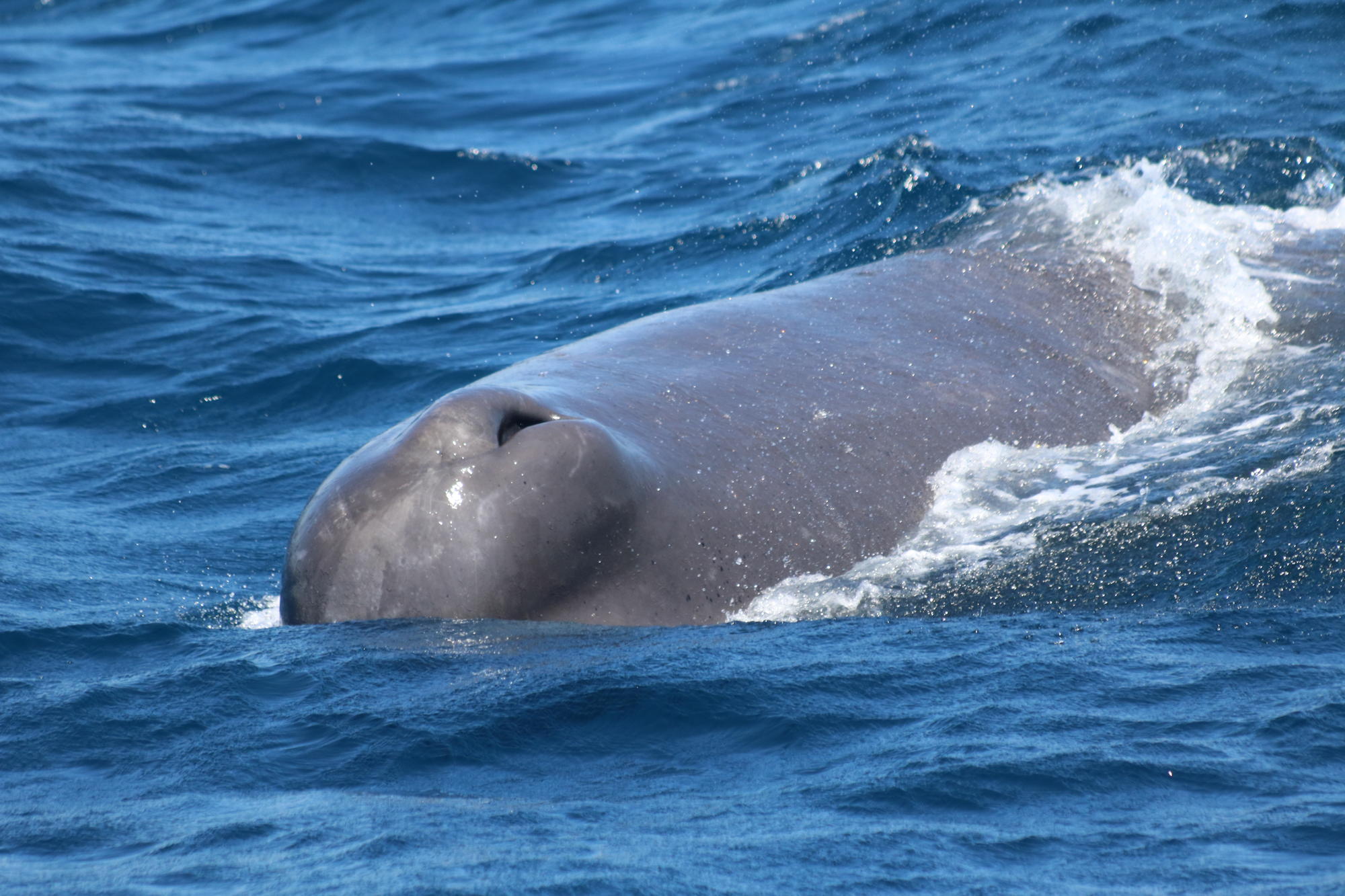Sperm Whale (Physeter macrocephalus)

What do we know about the Sperm Whales in the Strait of Gibraltar?
Most of the time we can see Sperm Whales from a distance. Between two dives they always float for a few minutes on the water surface and fill their blood with oxygen. Since the blowhole is on the left side of the skull, the blow is ejected diagonally forward to the left: a clear signal that it can only be a Sperm Whale.
An angled blow already tells us from a distance when a Sperm Whale has appeared.
We recognize some Sperm Whales by their characteristic flukes and we know that they spend several weeks each year in the Strait of Gibraltar before swimming back into the Mediterranean. A Sperm Whale, whom we call Observador, is particularly curious and occasionally swims very close to the firmm boat.
We rarely meet groups of Sperm Whales in the Strait; they usually seem to be alone. And even for the encounter with a single Sperm Whale you need a bit of luck. All the more impressive are the exceptions, as for example in September 2017, when we were able to observe 10 Sperm Whales at once.
Does the east wind influence the occurrence of Sperm Whales?
An evaluation of our data regarding weather conditions suggests that there may be a connection between Sperm Whale sightings and Levante frequency. Levante is the sometimes very strong east wind, which can last several weeks - in such years we usually have fewer Sperm Whale sightings. Find out more in our research report on the Sperm Whale.
Sperm Whales are true masters in diving
Sperm Whales can stay under water for up to 80 minutes. When diving down, the whale lifts the entire fluke out of the water before disappearing vertically into the depths of the Strait. We can observe this very well from our boat.
A special feature of the Sperm Whale is the large head, which accounts for about one third of the total length. Here, the so-called spermaceti-organ is located, which contains an oily waxy liquid, the spermaceti. With the help of the spermaceti-organ the Sperm Whale bundles its sonar, for this purpose the spermaceti must be liquid. If the Sperm Whale wants to dive down, he pumps water through its right nasal passage. Thus the spermaceti cools down, solidifies at 31°C and becomes heavier, which helps him to dive down the first 100 meters. Whalers mistakenly considered the spermaceti as the sperm of the whale, hence the name.
Whaling and other dangers
The spermaceti became the fate of the Sperm Whales, since it was found out that lubricants and fuel for oil lamps can be produced from it. The relentless hunt for Sperm Whales did not end until 1982. Between 1920 and 1960, the whaling stations of Algeciras and Ceuta in particular contributed to the reduction of the local population.
Unfortunately, the population of the Sperm Whales is still endangered in the Mediterranean, their number decreases further. One of today's dangers is the collision with ships. Also the plastic pollution of the oceans leads evermore frequently to deaths. At the end of February 2018, a starving Sperm Whale stranded in the Spanish Mediterranean region of Murcia, in whose stomach over 29 kilograms of plastic bags, ropes, fishing nets and so on were found. As toothed whales pick up their prey in a targeted manner, we fear that hunger will drive the animals to simply swallow everything in the largely empty Mediterranean Sea.
Facts worth knowing

- dark grey to light brown body
- squarish head makes up one third of the body length
- blowhole on left side near front of head
- high blow projected forward and to the left
- low hump in place of fin, "knuckles" from hump to flukes
- broad fluke with distinct notch in the middle (clearly visible when diving down)
- prefers deep waters
| Sperm Whale (Physeter macrocephalus) | |
|---|---|
| Suborder: | Odontoceti (toothed whales) |
| Family: | Physeteridae (sperm whales) |
| Size: | 11–18 m, 20–50 t |
| Size at birth: | 4 m, 1,000 kg |
| Life expectancy: | 70–80 years |
| Sexual maturity: | with 9 years (9–12 m) |
| Reproduction: | every 5–7 years |
| Gestation period: | 14–15 months |
| Nursing period: | 24-50 months |
| Food: | squid, octopi, crustaceans, fish (3 % of their body weight/day) |
| Speed: | approx. 30 km/h |
| Diving time/depth: | up to 80 min, up to 3,000 m |
Sperm Whale – Video















